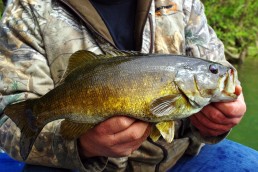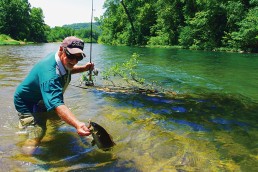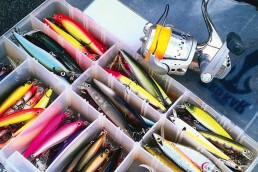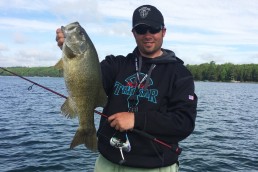Float your Day and Troubles Away for Jack’s Fork Smallmouths
SHARE THIS POST
Floating the Jack’s Fork in Missouri is a premium outdoor experience with spring-fed waters flowing sparkling-clear over riffles with ancient gravel shimmering in gold, copper and cream. In some riffles, the water jumps and dances around hundreds of small humps and points that sparkle in the sunlight. The river bends and meanders through the heart of the Ozarks, blanketed with a hardwood canopy and slips past towering rocky bluffs that rise perpendicular from the river.
The Jack’s Fork is part of the Ozark National Scenic Riverways and is part of the National Park System, so each side of the river, and the river itself, is public land. Jack’s Fork doesn’t have the long, deep, slow pools of larger rivers, so not much paddling is required. But it does have deeper runs where the water assumes the rich emerald hue of spring water. The deeper runs against the bluffs are littered with boulders and rubble rocks that over time have loosened and tumbled from above to create ideal fish habitat. Crayfish, hellgrammites and aquatic insects harbor and hide here, and the minnows utilize the broken cover for safety and feed on the smaller insects. Lots of smallmouths cruise in the crevices to ambush and consume anything here that will fit past their gaping maws.
I used to guide other fishermen on this and other Ozark rivers, but these days, I only guide my golden retriever “Doc.” There’s no hurry, no deadlines or appointments, and cellphones don’t work here so I fish as the current sets its timeless pace. I fish as I float along in areas ideal for runs or beach the canoe to wade while Doc sniffs and hunts.
In rivers, smallmouths behave more like trout than bass found in lakes. Smallmouths desire a certain velocity of flow, but they utilize a rock or log to break that flow so they can rest in place with little effort. The faster currents swirling around them offer a smorgasbord of weakened or unsuspecting creatures. When one of these morsels drifts, scampers or swims by, they dart out and grab them with admirable speed and veracity then dart right back into their stationary positions, much like trout. The only real difference is that smallmouths are bottom-huggers, so whatever you fish it works best if it bumps or swims along the bottom.
Are you enjoying this post?
You can be among the first to get the latest info on where to go, what to use and how to use it!
Smallmouths are the top predators in these waters, with the exception of swifter and meaner river otters that menace even the largest fish. In the quieter places of these rock-studded runs you’ll find goggle-eyes. These tenacious, aggressive runts hit hard and tussle mightily. For their size, they are great fun on light tackle and a palatable treat if they’re scaled and fried almost immediately. (A new rule this year: goggle-eyes here must be at least 7 inches long to keep while the daily limit is 15.)
Many lures catch river smallmouths, but those that work best are small. Most people I see use baits designed more for largemouths. My favorite lures include 1/16-ounce Road Runners with a curly tail, Strike King’s Mini-Spins, 3-inch Flukes, Charlie Brewer Bass Sliders and the venerable Beetle Spin. These can be fished on 6- or 8-pound-test monofilament with Carbon X Rods. Slower is better too, as many of the best smallmouths are caught while the lure is dropping.
To float and fish this river, take your time; stop to wade likely runs. And don’t forget to start early to stay ahead of the party floaters. You’re likely to catch a lot of smallmouths and goggle-eyes, but even if you only get a few, just floating on Jack’s Fork is an experience you must try.
MWO
SHARE THIS POST
Did you enjoy this post?
You can be among the first to get the latest info on where to go, what to use and how to use it!
Ron Kruger
Ron Kruger has been communicating the outdoor experience for more than four decades. He has worked as a full-time guide for trout on the North Fork, for crappies and bass on Kentucky Lake and for smallmouths on the Current River. He has served as editor of three outdoor magazines, and owns a patent on a fly/lure called the Desperate Diver.



